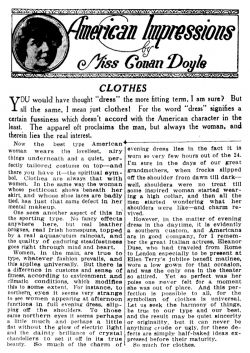Clothes
| << Social Functions in the West #2 | American Impressions | #4 Women in Business >> |
Clothes is the third article of the series American Impressions by Miss Conan Doyle written by Mary Conan Doyle, the first daughter of Arthur Conan Doyle, in the Los Angeles Evening Express on 17 may 1920.
Clothes

(17 may 1920, p. 4)
You would have thought "dress" the more fitting term, I am sure? But all the same, I mean just clothes! For the word "dress" signifies a certain fussiness which doesn't accord with the American character in the least. The apparel oft proclaims the man, but always the woman, and therein lies the real interest.
Now the best type American woman wears the loveliest, airy things underneath and a quiet, perfectly tailored costume on top — and there you have it — the spiritual symbol. Clothes are always that with women. In the same way the woman whose petticoat shows beneath her skirt, and whose shoe laces are badly tied, has just that same defect in her mental makeup.
One sees another aspect of this in the sporting type. No fancy effects anywhere here, but real leather brogues, real Irish homespuns, topped by a real aquascutum raincoat, and the quality of enduring steadfastness goes right through mind and heart.
Women, in the main, are true to type, whatever fashion prevails, and this applies universally. But there is a difference in customs and sense of fitness, according to environment and climatic conditions, which modifies this to some extent. For instance, to northern eyes it seems very strange to see women appearing at afternoon functions in full evening dress, slipping off the shoulders. To those same northern eyes it seems perhaps a little much and perhaps a little flat without the glow of electric light and the dainty brilliance of crystal chandeliers to set it off in its true beauty. So much of the charm of evening dress lies in the fact it is worn so very few hours out of the 24. I'm sure in the days of our great grandmothers, when frocks slipped off the shoulder from dawn till dark — well, shoulders were no treat till some inspired woman started wearing a high collar, and then all the men started wondering what her shoulders were like — and charm revived.
However, in the matter of evening dress in the daytime, it is evidently a southern custom, and Americans are in good company, for I remember the great Italian actress, Eleanor Duse, who had traveled from Rome to London especially to be present at Ellen Terry's jubilee benefit matinee, wore a low gown for that occasion, and was the only one in the theater so attired. Yet so perfect was her poise one never felt for a moment she was out of place. And this perfection is possible to all, for the symbolism of clothes is universal. Let us seek the harmony of things, be true to our type and our best, and the result may be quiet sincerity or originality, but it can never be anything crude or ugly, for these defects are simply half-baked ideas expressed before their maturity.
So much for clothes.